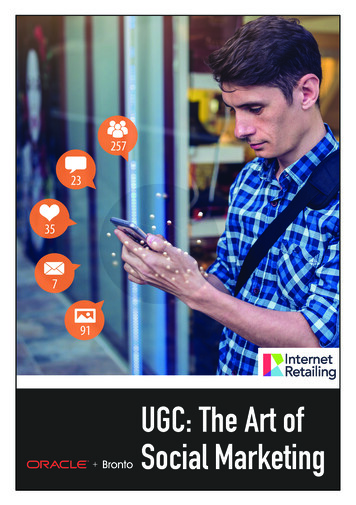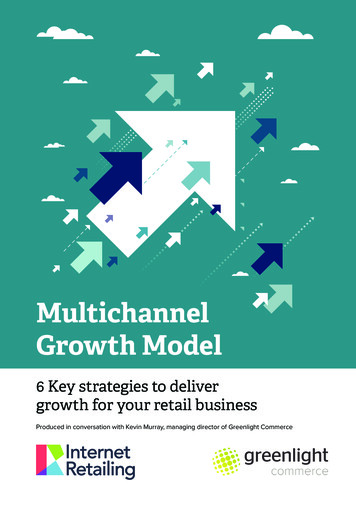
Transcription
UGC: The Art ofSocial Marketing
2 l bronto.comINTRODUCTION25% OF SEARCH RESULTS FORTHE WORLD’S TOP 20 LARGESTBRANDS ARE LINKS TO USERGENERATED CONTENTSOURCE: OLAPIC25%Social media has given rise to many new phenomena, but one of themost interesting is user-generated content (UGC). Camera-enabled,always-connected smartphones offer consumers the opportunityto share the minutiae of their lives. And while many selfie their waythrough their days as a way to share with friends and family, othersuse their cameras to share images and videos with the world.Consumers use social media not only to show off what they aregoing to have for lunch, but also what they want to buy, whatthey have bought and how things work, and fit. This material ismarketing gold to retailers.For retail brands, UGC is rapidly becoming a keycomponent of their marketing campaigns as it offers anumber of advantages over traditional marketing.Consumers like and trust the views of their peersover those of brands themselves. Seeing what a peerthinks about something is much more authentic. Froma practical standpoint, UGC can show off what goodslook like and how they work in real life. In the fashionretail space, potential customers get a better understanding of how a dress or top looks on a real person andhow it hangs, flows or fits. For technology companies, UGCcan help consumers learn how to use their products. Look at thenumber of consumers that turn to YouTube and social media to augmentthe instructions that a camera, tent or software product comes with.Perhaps the biggest reason to consider UGC? It is cost-effective andmore compelling than traditional advertising and marketing messages.Companies that A/B test user-generated content vs. staged photosand videos often find the user-generated content more engaging.bronto.com
internetretailing.net l 3And it works particularly well with millennials. According to Bazaarvoice1, more than80% of millennials say that UGC has aninfluence on whether they buy or not. Andthey are the most prolific shoppers, spending more money online than any other agegroup despite having lower incomes thanolder adults, according to Business Insider2.UGC also delivers another perk: better SEO.According to Kissmetrics3, “25% of searchresults for the World’s Top 20 largest brandsare links to user-generated content.” Positivecustomer reviews can raise your SEO ranking,while analysing the words and phrases mostfrequently used by your audience can improveyour keyword optimisation research.In this ebook we’ll help you understand: What UGC is and why it is important. How to collect it. How to curate it. How to use it in marketing.We’ll also provide some examples of greatUGC campaigns.REFERENCES1 ite-papers/Social-Trends-Report-2013.html2 t-spending-habits-than-parents-2017-83 cs/“For retail brands, UGC is rapidly becominga key component of their marketingcampaign as it offers a number ofadvantages over traditional marketing”internetretailing.net
4 l bronto.comPART ONE:WHAT IS UGC?User-generated content conjures upimages of selfies, people’s dinners, orvideos of cats doing amusing things.However, there is much more to it thanthat: increasing numbers of consumersare logging their experiences – good andbad – with items and services, showingoff things that they have just bought andposting their wants and desires. Many arealso keen to offer helpful hints into how tooperate things or ‘hacks’ that help you getmore out of the goods you’ve bought.Taken together, these public contributions offer brands a powerful library ofcontent that can be used in marketing,promotion and even development ofnew products and services. Let’s reviewseveral UGC options.uploading a photo. Forty per cent of themdo it to show their immediate friends andfamily what they have bought or what theylike, while 45% look at user-generatedcontent for inspiration at least once a day.The Olapic research also notes that socialmedia users are seven times more likelyto trust UGC images than advertising,while 76% of those that do trust UGCview content posted by other customersas more trustworthy and honest thanadvertising.As a result, 56% are more likely to buya product after seeing it featured in apositive and relatable way through UGCand 49% are more likely to buy productsendorsed by UGC.SOCIAL MEDIA CONTENT: PICTURES, VIDEOS AND TEXTThere are five major platforms thatinternet users are active on: Twitter,Pinterest, Facebook, Snapchat and Instagram. Facebook is in the lead, but Instagram and SnapChat are rapidly growingin terms of usage. Many users also linktheir social feeds together, so posting onFacebook or Instagram will also fire up apost on Twitter.According to research from visual commerce company Olapic1, 74% of peoplehave hashtagged a brand name whileREVIEWSThe richest and most obvious source ofUGC is social media. Given the functionality of smartphones, this content nowfeatures not just words but also photosand videos of products being put throughtheir paces in the real world. The visualcontent is particularly useful for prospective customers.bronto.comWhile photos and videos shared acrosssocial media are two very visual exam-
internetretailing.net l 5ples of UGC, reviews also play a criticalrole. Since the early days of the web,reviews have been an important resourcefor shoppers and retailers. Customersactively seek reviews when they aremaking a purchase online.Reviews present a powerful marketing tool: They build trust in a brandor company. According to a study byBrightlocal2, 85% of people trust onlinereviews as much as a personal recommendation, and 58% consider a starrating essential for a business. Moreover,70% of consumers say they need to reada minimum of four online reviews beforethey can trust a business.Reviews can be delivered in many ways.You can collect social media reviews,seek them from your product buyers viaemail, or use a third-party review site.The latter has several advantages: itsaves brands having to do the collectingthemselves and it often allows a greaterdegree of sophistication in how those reviews are used. For instance, a third-party platform can apportion the right reviews to the right product pages on yoursite. A third-party website can also reachmore people. Trustpilot, for instance,currently has some 40 million reviews of170,000 businesses worldwide.56% ARE MORE LIKELY TO BUY A PRODUCT AFTERSEEING IT FEATURED IN A POSITIVE AND RELATABLEWAY THROUGH UGC, AND 49% ARE MORE LIKELYTO BUY PRODUCTS ENDORSED BY UGC56%SOURCE: OLAPIC49%The biggest benefit of third-party reviewsites is that they are independent and,more importantly, are seen to be independent by prospective customers.Reviews have to be genuine – and consumers can spot when they are not. Third-partyreview platforms have built sophisticatedtechnology into their systems to spot fakereviews and will impose penalties.internetretailing.net
6 l bronto.comReviews can have a positive impact onsales. Star ratings and review snippets,show up now on search engine results. According to Econsultancy3, that can lead to a10-20% increase in click-through rates.Using a service to help you email customers with a survey is another option.There are companies that can help youengage consumers that have product experience, encouraging them to not onlyreview your company, products and services, but also help other customers withproblems, questions and information.Platforms that allow customers to talkwith each other, answer questions andengage are not new, but there is growingevidence of ROI – not just in attractingnew customers, but also in creating loyalty among those that participate in thecommunity. People who receive answersto questions convert at a higher ratethan those that don’t.PRODUCT DEVELOPMENT CROWDSOURCINGWhile social media and reviews make upthe vanguard of UGC, there is increasinginterest in using data garnered fromboth to help not only marketing, butalso within the wider business to shapeproduct ranges and launch new goodsand services.bronto.comThe idea of crowdsourcing isn’t new,however, using UGC to accomplish itis. Looking at how people are talkingabout your existing products by followinghashtagged content and searching outkeywords on social media can help youunderstand a lot about the markets youoperate in.You can look at content and reviews toassess how your existing products arebeing used and, more importantly, anyshortcomings that are being talkedabout and demonstrated. By assessingall this information, you can effectivelycrowdsource a vast amount of user dataabout what your existing customers dowith your product, want to do with it, anddo and don’t like about what you offer.You can also see what they say about thecompetition.More subtly, you can use social mediain general, and UGC in particular, to understand where there may be gaps in themarket for products that you could produce.The problem with this is how to make ithappen. According to a research paper4by MIT PhD student Artem Timoshenkoand MIT Kirin Professor of Marketing John R. Hauser: “User-generatedcontent (UGC) provides an opportunity
internetretailing.net l 7to better identify customer needs formanagerial impact. However, established methods are neither efficient noreffective for large UGC corporationsbecause much content is non-informative and repetitive.”Their research looked at how machinescan assess actual and potential customer needs based on what customers posted on social media, effectively automating the crowdsourcing of data from UGCfor product and company development.Users don’t just write on their social media platforms, they also share video andpictures. Thus, combing social mediafeeds is no longer an old-school text analytics task, but one that requires muchmore sophisticated image recognition.Multiple companies have released artificialintelligence (AI) engines to work on thetask, rolling out social media imagerecognition tools that analyse social traffic– words, images and context of both – anduse it to measure consumer sentiment,evaluate trends, gauge the reactions to aproduct or event and determine the effectiveness of marketing campaigns.What does this mean in practice? Today,brands can use these tools simplisticallyto find posts that contain their brand,or logo, or product. They can also beused to find the most common locations a product is used or talked about.This can be deployed to find the kind ofcontent a brand wants for a specific UGCcampaign, to garner a vital and more indepth understanding of where, when andhow its products are used.As AI technology becomes more sophisticated, it will lead to even more options toassess and understand what is happeningon social media and use that data to aideverything from product development tomarketing to servicing to loyalty.REFERENCES1 es-emea/2 eview-survey/3 merreviews-why-you-need-them-and-how-to-use-them/4 https://papers.ssrn.com/sol3/papers.cfm?abstract id 2985759internetretailing.net
8 l bronto.comPART TWO:HOW TO COLLECT UGCUGC is useful and impactful. Now let’sreview how to gather it.SOCIAL MONITORINGThe simplest way to find UGC about yourbrand is to go onto social media networksand look at what people are saying aboutyou. If you already have accounts with thosesocial media networks, you can do this easily by searching for your brand name andkeywords and checking direct messagingpointed at you. If not, you need to start oneon each feed to find all relevant content.This will let you see what is being said aboutyou. Step two is to pick up the thread andactually talk to your customers through allthese channels. You can start a dialogue, byencouraging them to use the right hashtagsor direct message them so that you areinvolved and notified once they start to postcontent about you.Once you have this access, you can start tolook at the content you may procure andbronto.comask them for permission to use it. If youask for the permission publicly, you aretipping off other brand admirers that youare looking for UGC and can inspire them toshare their own.REVIEW MONITORINGSimilarly, you should be looking at allyour reviews across your own site, anyother third-party sites you use andreview sites, blogs and other onlineproperties where you are mentioned.Checking reviews on your own siteand across third-parties that you havecontracted to work with is simple – iftime consuming – as you should haveready access to the reviews and will bealerted either by your content management system, web-host control panel orthird-party when reviews come in.What is more difficult is keeping tabson where people are talking about yououtside of social media. Bloggers willhopefully share their own content via
internetretailing.net l 9social media with relevant hashtags andkeywords, so you can locate that easilyenough through social monitoring.For other mentions, you will simply haveto get busy with Google and set up alertsfor when you or key words you are interested in are mentioned.Another way to garner reviews is toissue short, one-question surveys aboutwhat the customer has purchased. Thiscan produce useful, quotable contentand also generate invaluable feedbackon your products and services that canagain feed into product development,product marketing and even website andlogistics elements of your sales process.For flash sale sites and rapid-turnoverretailers, this sort of feedback needs to begenerated instantly, so it is often wise tolaunch a one-question survey at checkout that asks, “Why did you choose this?”For less time-sensitive offerings or linesunlikely to be discontinued, this survey canbe conducted via email, social media oreven SMS.SOCIAL MEDIA CAMPAIGNSRather than just hoping people are talking about you, you can start social mediacampaigns to generate content that suitsyour marketing purposes. Work out whatyou are looking for content-wise and howyou are going to use it (see Part 4: how touse UGC), then hit social media.You don’t have to limit yourself to onechannel, but it makes sense to start withone channel and create a funnel (throughjudicious use of hashtags) to directcustomers to that channel to deliver thecontent.According to BrandsWithFans5, “The bestway to source UGC is to focusinternetretailing.net
10 l bronto.comon the social networks your brand is alreadyparticipating in. Instagram and Twitter arethe most marketing friendly platforms forhashtag conversations and collecting publicphotos and videos. Facebook can also be asource of UGC if the brand has an engagedaudience that will elicit a high response toPage posts requesting submissions in comments. Facebook is not search friendly forfinding public conversations by people (notother Pages) that are re-sharable.”Now UGC campaign, it laid out a multichannelcontent marketing strategy to gather audiencesubmissions, create content and distribute it.Basics for encouraging UGC: Choose a unique hashtag – create onethat your audience will readily identify withyour brand and what you do. Ask that the audience use your hashtag– spread the word via social media, yourwebsite, email and other marketing channels. Monitor the hashtag – set up hashtagmonitoring using tools that assess whereand when you are being talked about andfeed you that content.When Cision PRNewswire6 launched its #PRis-EMAIL CAMPAIGNSbronto.com“In the case of #PRisNow, we started with ablog post on Beyond PR, then created customized posts for different social media channels,messaging that internal advocates could sharewith their networks, influencer pitches, andoutreach via ProfNet’s free query service,” thecompany explains.Email can also play a big role in UGC marketing, because it taps into your existing user basethat is likely engaged with your brand or site.Here are some things you can do with email togenerate UGC: Send out marketing emails specificallyasking for content – Adore Me and Footlockerare two great examples of this. They bothsent out emails explicitly asking contacts toengage with them by taking selfies wearingAdore Me clothes and Footlocker-purchasedtrainers, letting them know their UGC may beused in future messages. Run a contest – Contests are a great way tointegrate social in an email campaign. Oneexample would be a social media scavenger hunt with clues hidden across yoursocial channels. With this type of contest,you’ll want to include email as a part of thecampaign with one of the clues coming from
internetretailing.net l 11this channel. It can be an effective way topromote your email sign-up via your socialsites, as you can advertise the contest in advance on those channels in an effort to gainadditional subscribers7.In these examples from Adore Me andKlean Kanteen, both brands do a good jobof driving their email subscribers to theirsocial channels. Ask questions and start conversations– Does your email include a special topicthat connects with people emotionallyor includes some kind of unique offer? Ifso, encourage subscribers to share theirresponse to it with your audiences. You caneven ask them to share using a specialhashtag and provide a fill-in-the-blankcomment. For example: “This 50% discountfrom @TwitterHandle makes me feel .#SavingsDay”.Here is a great example from Maggie Sottero.Weddings, of course, are very emotionalevents, and you can do a great job of havingpast customers relive the moment.This not only helps connect with pastcustomers but also helps engagefuture customers.Another great way to regularly engageusers with your emails is to offer aquestion of the day or week and postanswers from subscribers on yoursocial site(s). Be sure to tailor yourcampaign to your particular social site.For Instagram, allow pictures to serveas answers. In this example from anOverstock.com email (below),the concept of engagement was there,but it would have been better to includea hashtag rather than forcing people toclick through the banner.REFERENCES5 -user-generated-content-marketing/6 .html7 g/internetretailing.net
12 l bronto.comPART THREEHOW TO CURATE UGCGetting users to start creating contentthat you can use is only the first step ina UGC marketing strategy – you haveto store it, categorise it, manage it anddecide on the best contributions.content on. Doing this publically canbe great additional publicity – and willhopefully lead the creator to also reshare your request and drive even moreclicks and content creation.So what do you need to do with it to makeit useful for your marketing campaigns?But there is a catch to asking for permission publicly: It opens you to a verypublic rejection in the unlikely event thatthey should say no.GET PERMISSION TO USE ITThe first and most vital part of the process is to get approval from the contentcreator to use it. The content may wellhave been born out of your requests, butit still belongs to the person who createdit and you need to make sure that theyare happy for you to use it.How do you do this? Just ask them. Thisis known as explicit permission. But thinkabout how you ask them. Usually, if theyhave been inspired by a campaign that youhave invited them to take part in, they havegiven implicit permission for you to usetheir content – especially if it features aspecific and unique hashtag associated withthat contest, campaign or call to action.While implicit permission is recognisedlegally, it is always wise – and polite – toobtain explicit permission.To do this, you can contact them via thesocial media feed they have created thebronto.comBetter, ask them via direct messaging,email or other private channels for theirpermission. If they agree and are reallypleased, they will share the requestanyway.If the content was created using yourproduct or brand entirely off the user’sown bat and not prompted by a call toaction from you, you need to tread evenmore carefully. Usually, people are happyto share, but since it was unsolicited,you need to send them a private DM oran email to explain who you are, how youfound the content and what you want todo with it. And be prepared that they maywant a creation credit.According to lawyers at Shareroot9,getting this permission can be surprisingly difficult and so many brandsprefer to simply use content their users
internetretailing.net l 13generate as they see fit without askingfor permission explicitly or creating asituation where it is granted implicitly.Using photos that feature unintentional“brand placement” for marketing purposes has created some of the biggestlegal headaches for brands in almostevery industry.Using content that was not specificallycreated for your brand (via a campaign,for example) without permission couldland you in hot water. This includes photographs of a celebrity using a certainbrand or private photos with accidentalbrand placement.Businesses can be sued for the abovesituations on the grounds of unauthorised use of an individual’s image formarketing purposes. The bottom line?Don’t use content without the creator’spermission—it’s not worth the trouble.As always, it is best to check with thelegal department when embarking ona UGC campaign – just so you all knowwhat you can and can’t do.HOW TO STORE IT, CATEGORISE IT AND MANAGE ITOnce you have permission and have gothold of the content, you then face thechallenge of what to do with it: where do“Businesses can be sued for theabove situations on the grounds ofunauthorised use of an individual’simage for marketing purposes”internetretailing.net
14 l bronto.comyou put it and, more pressingly how doyou categorise it in such a way that youcan use it?The technology space around UGC isbuzzing as more and more companiesrecognise the value of this type of content for their business. Olapic, Stackla,Annex Cloud and others all play into thisspace with platforms and solutions thathelp you manage and curate content.The easiest thing to do is to opt for acontent management engine that willcollect, collate, categorise and curatecontent. Using machine learning and AI– today’s argot for algorithms that lookfor patterns – these platforms can trawlsocial sites and other online feeds, looking for keywords, phrases, hashtags,logos, images and more and pullingthem in for deeper assessment.Once collected, all this content is thensubjected to a much deeper interrogation by AI to determine much moreaccurately how on-brand the content is,or how well it fulfils whatever criteriayou have imposed on it for your UGCcampaign.There is typically a stage for humans toreview the content before it is then catebronto.comgorised and stored, ready for use.The really clever engines also featurethe ability to manage the rights too,requesting rights from the creator andmanaging the outcome. They then storeand organise all this content in an easyto-use dashboard that the marketingdepartment can use to find what theyare looking for – knowing where it camefrom, when, why and from whom.MODERATION AND SELECTIONPart of the process of picking the contentinvolves making sure that it is on-brand,that it doesn’t infringe other brands’ copyright, or interfere with people’s privacyand that it is neither indecent nor offensive. This can be largely automated. Butdeciding what content is actually good ismuch more subjective.Here humans come into play. For bigbrands, there could be thousands, hundreds of thousands or even millions ofbits of relevant vetted content. Machinescan whittle this down to a manageableamount, but then people have to step into assess what content fits with what theyare trying to achieve.To achieve this, marketers can make useof the aforementioned dashboard to pickthe content they want (and to make sure
internetretailing.net l 15that the AI hasn’t overlooked somethingreally offensive). They can manuallyselect the pieces of content they want touse and where and how.With reviews, some degree of automatedmoderation occurs to weedle out thingsthat are offensive and, with the increasing sophistication of third-party systems,fake reviews. This streamlines the vetting, but all reviews still need some sortof manual intervention before going live.(as we shall see in Part 4: How to UseUGC) – you need to be able to pick theright content at the right time and deployit. You need to link your content management systems to your marketingsystems to try and automate as muchas possible. But be prepared for somemanual tasks.Reviews are interesting as they often bega response – particularly the bad ones.While a brand or business should neverget into a slanging match with a customer – least of all in public – a bad reviewhandled well can turn into a PR win. Ifyou understand their problem, and canfix it, you can showcase it online.CONNECTING CONTENT TO CAMPAIGNSMapping the content that you havegarnered to the right campaigns andproducts is a tough call – made tougheras the volume of content goes up.Here you need again a combination ofmachine learning and human input.Depending on what you want to do – anemail campaign, a social media campaign, or even a social selling campaignREFERENCES9 at-youneed-to-know-part-1internetretailing.net
16 l bronto.comPART FOURHOW TO USE UGC INMARKETINGThe effort to gather and curate all ofthis user-generated content will be fornaught if you don’t effectively deploy it.There are three things you can use UGCfor: engaging customers and fans; sellingdirectly; and helping consumers learnmore about your products, business andcustomers.ENGAGING WITH CUSTOMERSReviews, too, are about engagement.Encouraging people to write about theirexperience builds a bond between youand them. While many people will onlywrite a review unbidden if they are upsetabout something, actively encouraginghappy customers once you have seenthem post something positive on socialmedia can yield positive results.As you roll out UGC, watch which customers contribute the most and see howtheir posts do. Are there certain poststhat seem to gather lots of likes? Or getre-shared frequently? Start to turn theseinto brand advocates – with sweetenersof early access to new lines, money off,or even just the glory of being a brandadvocate.With reviews, you need to work out wherebest to use them. Applying them to a specific product or service page on a websiteis a given, but you can also pull them outto use in specific marketing campaignsor beyond. If you send out a marketingemail about a particular product, includesome of the best reviews you have on thatitem.This is where UGC comes into its own.While it may be easy to look at it as justa way of reinforcing your relationshipwith your existing customers, it plays arole in acquiring new customers. It’s amultiplication effect. First, those postingattract the attention of their followersand then those followers attract additional attention.And getting positive reviews – and thestars that come with that – helps you engage further. Not only has that customerhad a positive experience, but startinga dialogue with them about their reviewcan make them more engaged with youas a brand and more likely to come backto you again. It also makes them morelikely to recommend you to friends andbronto.com
internetretailing.net l 17beyond – igniting again the whole brandadvocacy dynamic seen with other UGCcampaigns talked of above.However, speed is often of the essence.As we have seen, for flash sales orlimited edition lines, it is often best torequest reviews, surveys or stars at theimmediate point of sale and to then usethat data on your website and socialfeeds instantly.SELLING THROUGH UGCWhile brand engagement and loyalty aremust-haves, the real end game is to sellmore. After your UGC campaigns havegarnered all this interest and set you upas a social and celebrated brand, youneed to use this content to sell.Use your images and videos to push outmarketing materials with a sales-focusedmessage. If you ran a competition on whohas the best Instagram post about yourtrainers, now is the time to put those winning trainer images to work for you as partof more traditional marketing campaigns.Here you can use the imagery and videoon social channels, but also you can stickthem up on a billboard or build them intoemail marketing campaigns.You might focus on one “social product”per week or day that has a special price.You can choose one user-generatedproduct photo as the main hero imageand give credit to the user. Or you mightconsider testing an email that featuresmultiple products, such as a clearanceemail. Run an A/B test11 using socialor UGC photos in the email versus thestandard stock product images. In bothcases, analyse how these social sellingmessages convert compared with yourstatic promotional messages.Deploy your best reviews in emailmarketing about specific products or services. Let them do the selling for you.Running social media campaigns showsjust how interactive you are with yourcustomers, so you need to leverage that.Anecdotally, brand engagement risesnearly 30% when consumers are exposedto a combination of UGC and professionalcontent12. This is because they trust theviews of their peers and like the look ofthe pro content.LEARNING FROM UGCLearning from what the collected contenttells you is one of the most overlookedaspects of running a UGC campaign. UGCcan tell you so much you didn’t knowabout your customers, your products andyour business.internetretailing.net
18 l bronto.comFor starters, you can see which productsare most popular. But it goes way
EMAIL CAMPAIGNS Email can also play a big role in UGC market-ing, because it taps into your existing user base that is likely engaged with your brand or site. Here are some things you can do with email to generate UGC: Send out marketing emails specifically asking for content - Adore Me and Footlocker are two great examples of this. They both










